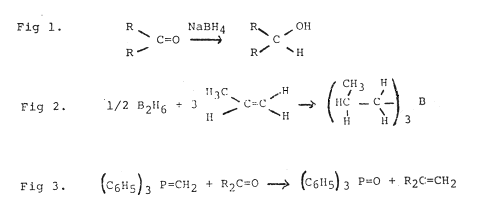Press release

15 October 1979
The Royal Swedish Academy of Sciences has decided to award the 1979 Nobel Prize in Chemistry jointly to
Professor Herbert C Brown, Purdue University, West Lafayette, Indiana, USA and
Professor Georg Wittig, University of Heidelberg, Federal Republic of Germany
for their development of the use of boron- and phosphorus-containing compounds, respectively, into important reagents in organic synthesis.
Nobel Prize in chemistry shared for work in organic synthesis
In contrast to most other natural sciences chemistry is not exclusively restricted to the study of Nature per se. Chemists can combine atoms into substances which do not exist in Nature. This is particularly true for organic chemistry, the chemistry of carbon compounds, where the possibilities for preparing new compounds are virtually unlimited. These possibilities have stimulated the development of chemistry and the practical consequences have been enormous.
The chemist soon learned to make dye stuffs which were both cheaper and better than naturally occurring dyes. Chemical explosives such as nitroglycerine were developed and their connection with the Nobel Prize is well known. Synthetic drugs have saved innumerable lives and spared mankind a great deal of suffering. The synthesis of vitamins and essential amino acids, used as food additives, have improved our diet, especially in developing countries. Plastics, which are a part of our daily lives, are products of organic synthesis on a large scale. Chemicals for controlling microorganisms, insects and weeds have saved millions of lives and reduced starvation. Many such substances, however, have long-lasting effects which cannot be accepted and chemists and biologists are trying to develop better preparations.
Access to efficient synthetic reactions has been a prerequisite for these developments and new synthetic methods have been developed during tile past 150 years. Some of these nethods have had such an impact that their originators have been awarded the Nobel Prize.
Boron compounds
Herbert C Brown, who is professor at Purdue University, has developed new reagents containing boron. He jokes about his initials H, C, and B, which are also the chemical symbols for hydrogen carbon, and boron, the elements contained in the compounds which he studies. One of his reagents is sodium boro-hydride, which has become the reagent of choice for reduction of carbonyl compounds (Fig 1). He has also modified the boro-hydrides into reagents for highly selective chemical transformations.
In addition Brown has introduced an entirely new class of compounds, the organoboranes, obtained by reacting diborane with olefins (Fig 2).
Thanks to the work of Brown and his coworkers, the organoboranes have become the most versatile reagents ever created in organic chemistry. They can be used for reductions, rearrangements and additions and have opened up a range of new possibilities for linking carbon atoms to each other.

The Wittig reaction
Georg Wittig has been professor in Freiburg, Tübingen and Heidelberg, and is now professor emeritus. He has developed new synthetic methods of considerable importance and has studied reaction mechanisms. His most important achievement is the discovery of the rearrangement reaction which bears his name. In the Wittig reaction (Fig 3) an organic phosphorus compound with a formal double bond between phosphorus and carbon is reacted with a carbonyl compound. The oxygen of the carbonyl compound is exchanged for carbon, the product being an olefin. This method of making olefins has opened up new possibilities, not the least of which are for the synthesis of biologically active substances containing carbon-to-carbon double bonds. For example, vitamin A is synthesized industrially using the Wittig reaction.
Brown’s and Wittig’s results have opened up new vistas in organic synthesis and highly stimulated the further development of their science. Their methods were rapidly introduced not only into chemical laboratories, but also into elementary text books and laboratory courses.
Nobel Prizes and laureates
Six prizes were awarded for achievements that have conferred the greatest benefit to humankind. The 14 laureates' work and discoveries range from quantum tunnelling to promoting democratic rights.
See them all presented here.
